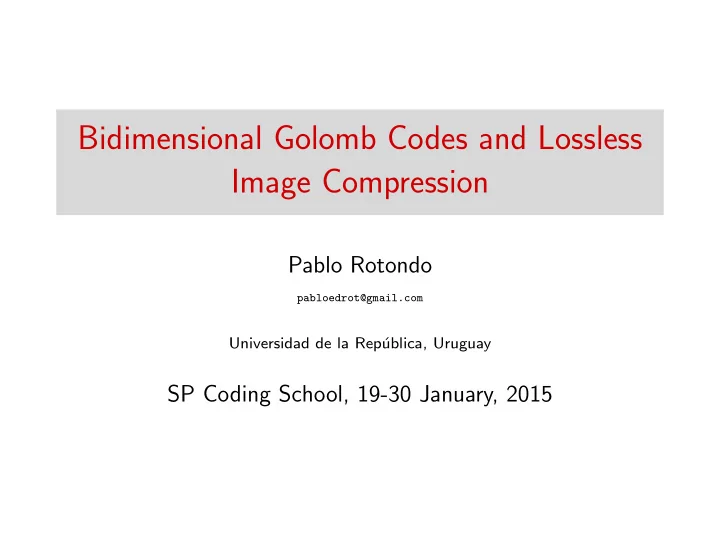

Bidimensional Golomb Codes and Lossless Image Compression Pablo Rotondo pabloedrot@gmail.com Universidad de la Rep´ ublica, Uruguay SP Coding School, 19-30 January, 2015
Golomb Codes Geometric Distribution A random variable X is said to be geometrically distributed with parameter q ∈ (0 , 1) if and only if Pr ( X = n ) = (1 − q ) q n for all n ∈ Z ≥ 0 . We denote this distribution by ODGD ( q ). Golomb Codes Family of binary prefix-free codes G k : Z ≥ 0 → { 0 , 1 } ∗ with ◮ G 1 ( n ) = 0 n 1 is the unary code. �� n �� ◮ G k ( n ) = G 1 · T k ( n mod k ) for k > 1. Here T k is k an optimal prefix free code for the source with symbols { i : 0 ≤ i < k } and weights w ( i ) = q i . The code G k is optimal for ODGD ( q ) when k is the smallest positive integer such that q k + q k +1 ≤ 1.
Golomb Codes in LOCO-I LOCO-I ( LOw COmplexity LOssless COmpression for Images ) is a lossless compression algorithm for grayscale images. It involves the following elements and ideas. ◮ A scan of the pixels in raster-scan order. ◮ A predictor for the intensity of the current pixel based on that of its already scanned neighbours. ◮ Causal contexts based on previously scanned neighbouring pixels = ⇒ statistics for the prediction error. ◮ The assumption that the prediction error 1 is well-modelled by a two-sided geometric distribution (with offset). ◮ Code the prediction errors by means of the simpler family ( G 2 k ) k ≥ 0 of Rice codes ⇒ simpler selection and coding. 1 Conditioned on the contexts, actually.
Coding pairs of independent geometric variables = ⇒ Coding in larger blocks leads to reduced redundancy. A pair ( X , Y ) of independent random variables with distribution ODGD ( q ) is said to have distribution TDGD ( q ). Optimal Bidimensional Codes Let k ∈ Z > 0 and q = 2 − 1 / k . Then C k : Z ≥ 0 × Z ≥ 0 → { 0 , 1 } ∗ defined by �� i �� j �� �� C k ( i , j ) = G 1 · G 1 · T k ( i mod k , j mod k ) , k k where T k is an optimal prefix-free code for the source with respective symbols and weights w ( i , j ) = q i + j , A k = { ( i , j ) : 0 ≤ i , j < k } , is an optimal prefix-free code for TDGD ( q ).
Coding pairs in LOCO-I Things done Conclusions and questions ◮ A selection rule for the ◮ A similar selection rule family C 2 k , and a derived holds for ( C 2 k ) k ≥ 0 . coding and selection rule ◮ Similar results hold for for a pair of independent higher dimensions. variables with two-sided ◮ Code-length advantage is geometric distribution. negligible ⇒ LOCO-I’s ◮ Implemented LOCO-I to predictor is too good. code RGB images. ◮ Other families of ⇒ Code G as before, bidimensional codes? code prediction errors ◮ Better models for ( ǫ R − G , ǫ B − G ) jointly when ( ǫ R − G , ǫ B − G )? appropriate.
References M. J. Weinberger, G. Seroussi, and G. Sapiro, The LOCO-I lossless image compression algorithm: Principles and standardization into JPEG-LS, IEEE Trans. Image Proc. , vol. 9, pp. 1309-1324, 2000. F. Bassino, J. Cl´ ement, G. Seroussi, and A. Viola, Optimal prefix codes for pairs of geometrically-distributed, IEEE Trans. Inform. Theory , 59 (4), April 2013.
Recommend
More recommend